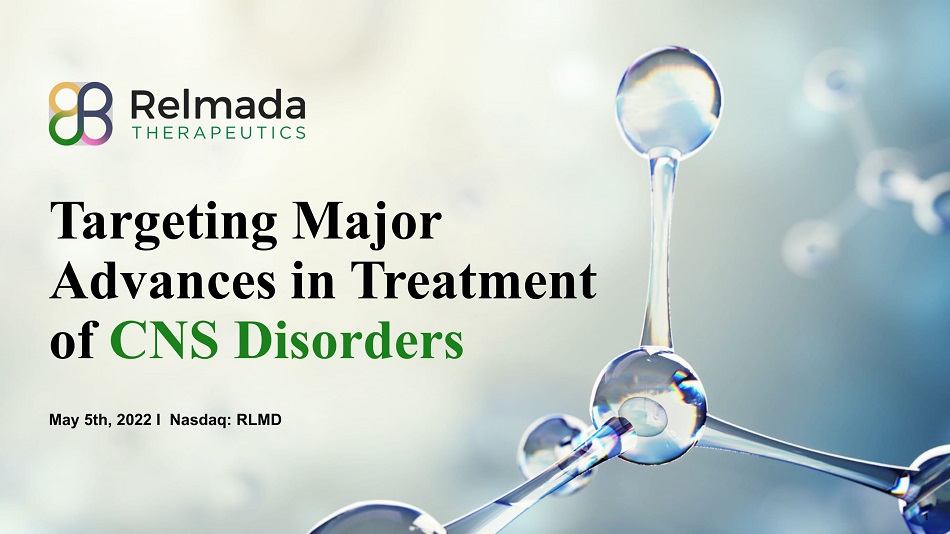
Exhibit 99.2

T a r g e t ing Major Advances in Treatment of CNS Disorders May 5th, 2022 I Nasdaq: RLMD 1
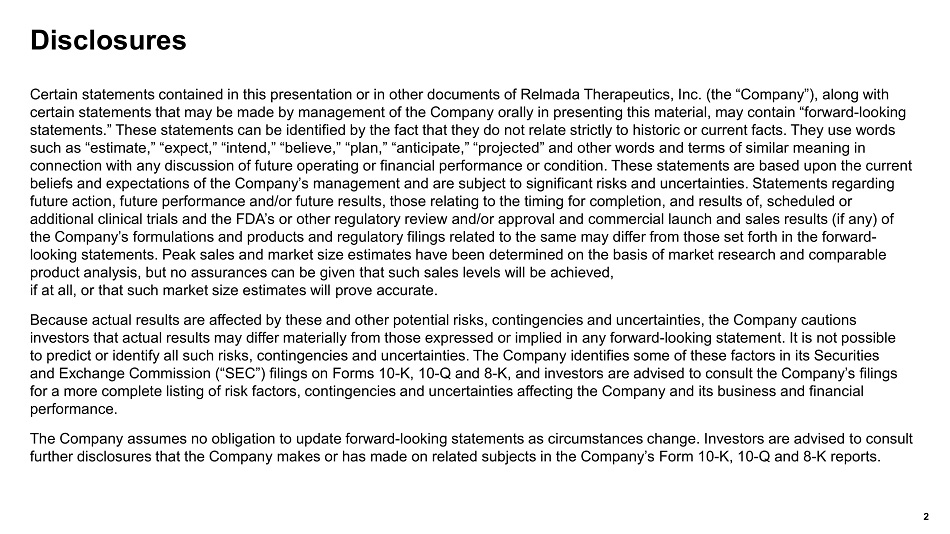
Disclosures Certain statements contained in this presentation or in other documents of Relmada Therapeutics, Inc. (the “Company”), along with certain statements that may be made by management of the Company orally in presenting this material, may contain “forward - looking statements.” These statements can be identified by the fact that they do not relate strictly to historic or current facts. They use words such as “estimate,” “expect,” “intend,” “believe,” “plan,” “anticipate,” “projected” and other words and terms of similar meaning in connection with any discussion of future operating or financial performance or condition. These statements are based upon the current beliefs and expectations of the Company’s management and are subject to significant risks and uncertainties. Statements regarding future action, future performance and/or future results, those relating to the timing for completion, and results of, scheduled or additional clinical trials and the FDA’s or other regulatory review and/or approval and commercial launch and sales results (if any) of the Company’s formulations and products and regulatory filings related to the same may differ from those set forth in the forward - looking statements. Peak sales and market size estimates have been determined on the basis of market research and comparable product analysis, but no assurances can be given that such sales levels will be achieved, if at all, or that such market size estimates will prove accurate. Because actual results are affected by these and other potential risks, contingencies and uncertainties, the Company cautions investors that actual results may differ materially from those expressed or implied in any forward - looking statement. It is not possible to predict or identify all such risks, contingencies and uncertainties. The Company identifies some of these factors in its Securities and Exchange Commission (“SEC”) filings on Forms 10 - K, 10 - Q and 8 - K, and investors are advised to consult the Company’s filings for a more complete listing of risk factors, contingencies and uncertainties affecting the Company and its business and financial performance. The Company assumes no obligation to update forward - looking statements as circumstances change. Investors are advised to consult further disclosures that the Company makes or has made on related subjects in the Company’s Form 10 - K, 10 - Q and 8 - K reports. 2
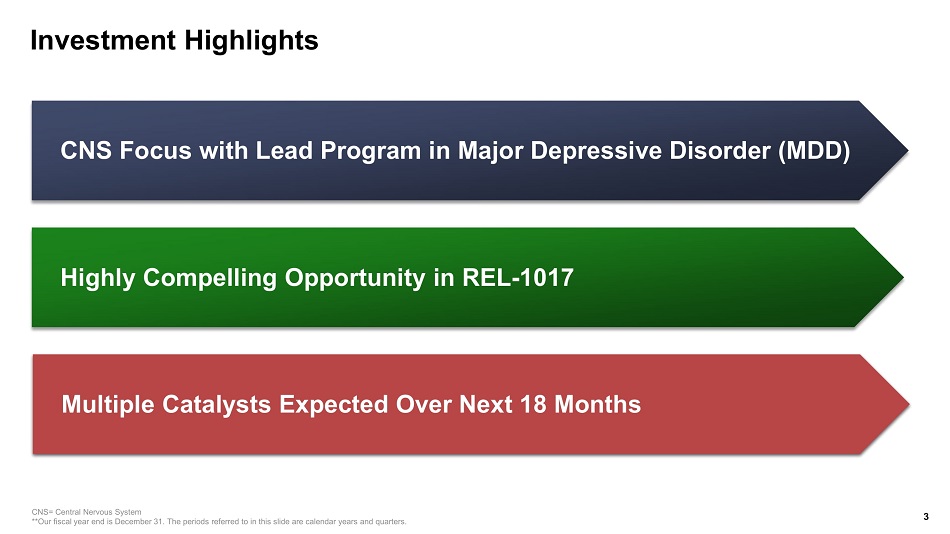
Investment Highlights Highly Compelling Opportunity in REL - 1017 Multiple Catalysts Expected Over Next 18 Months CNS Focus with Lead Program in Major Depressive Disorder (MDD) CNS= Central Nervous System **Our fiscal year end is December 31. The periods referred to in this slide are calendar years and quarters. 3
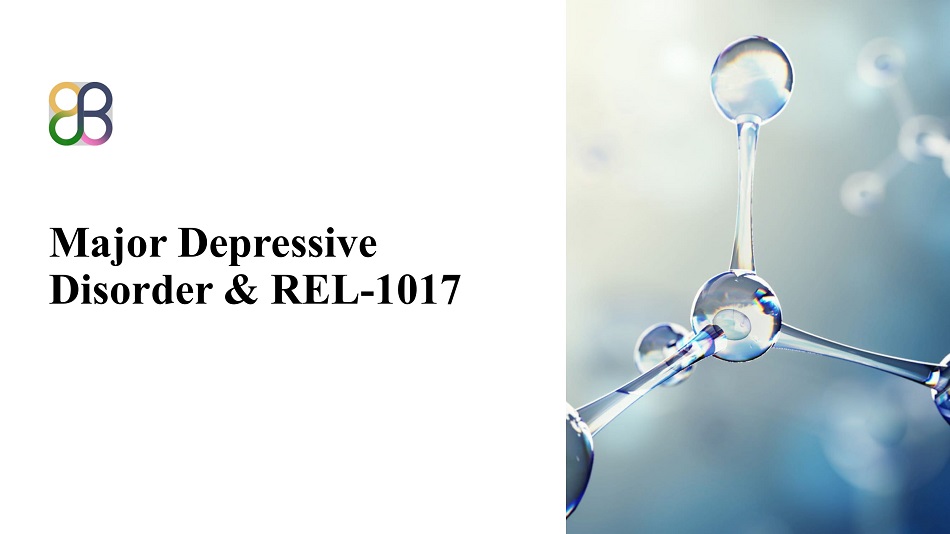
Major Depressive Disorder & REL - 1017
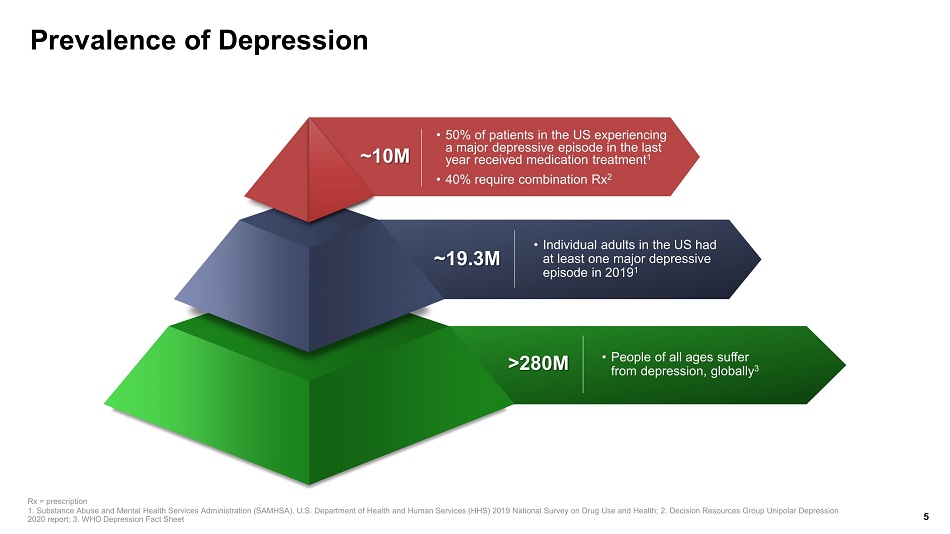
Prevalence of Depression ~10M • 50% of patients in the US experiencing a major depressive episode in the last year received medication treatment 1 • 40% require combination Rx 2 ~19.3M • Individual adults in the US had at least one major depressive episode in 2019 1 >280M from depression, globally • People of all ages suffer 3 5 Rx = prescription 1. Substance Abuse and Mental Health Services Administration (SAMHSA), U.S. Department of Health and Human Services (HHS) 2019 National Survey on Drug Use and Health; 2. Decision Resources Group Unipolar Depression 2020 report; 3. WHO Depression Fact Sheet
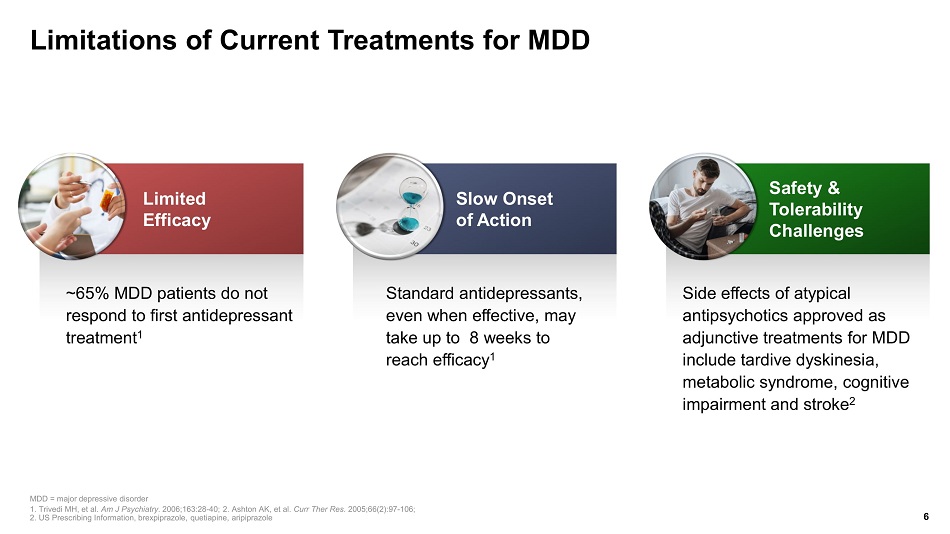
Limitations of Current Treatments for MDD ~65% MDD patients do not respond to first antidepressant treatment 1 Standard antidepressants, even when effective, may take up to 8 weeks to reach efficacy 1 MDD = major depressive disorder 1. Trivedi MH, et al. Am J Psychiatry. 2006;163:28 - 40; 2. Ashton AK, et al. Curr Ther Res. 2005;66(2):97 - 106; 2. US Prescribing Information, brexpiprazole, quetiapine, aripiprazole 6 Slow Onset of Action Side effects of atypical antipsychotics approved as adjunctive treatments for MDD include tardive dyskinesia, metabolic syndrome, cognitive impairment and stroke 2 Safety & Tolerability Challenges Limited Efficacy
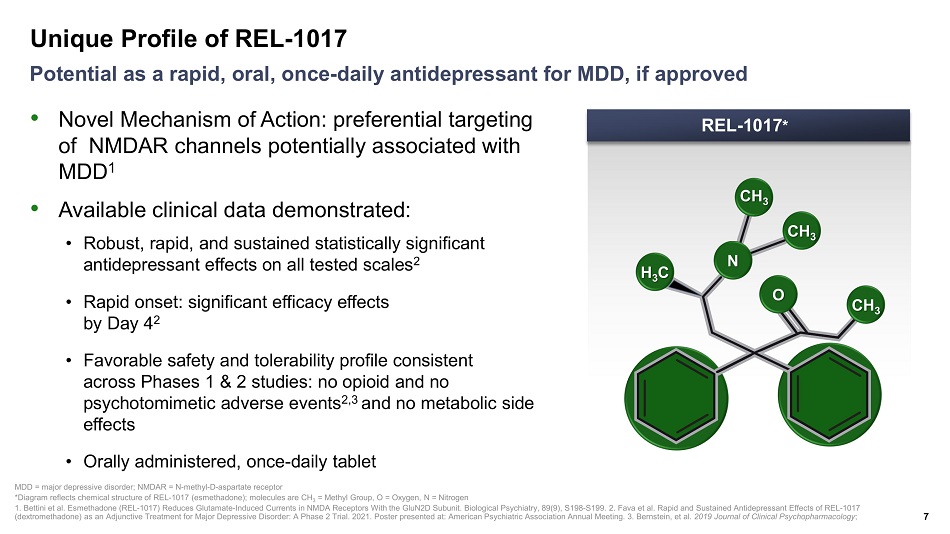
Unique Profile of REL - 1017 7 Potential as a rapid, oral, once - daily antidepressant for MDD, if approved REL - 1017 * CH 3 CH 3 CH 3 O N 3 H C • Orally administered, once - daily tablet MDD = major depressive disorder; NMDAR = N - methyl - D - aspartate receptor *Diagram reflects chemical structure of REL - 1017 (esmethadone); molecules are CH 3 = Methyl Group, O = Oxygen, N = Nitrogen 1. Bettini et al. Esmethadone (REL - 1017) Reduces Glutamate - Induced Currents in NMDA Receptors With the GluN2D Subunit. Biological Psychiatry, 89(9), S198 - S199. 2. Fava et al. Rapid and Sustained Antidepressant Effects of REL - 1017 (dextromethadone) as an Adjunctive Treatment for Major Depressive Disorder: A Phase 2 Trial. 2021. Poster presented at: American Psychiatric Association Annual Meeting. 3. Bernstein, et al. 2019 Journal of Clinical Psychopharmacology ; • Novel Mechanism of Action: preferential targeting of NMDAR channels potentially associated with MDD 1 • Available clinical data demonstrated: • Robust, rapid, and sustained statistically significant antidepressant effects on all tested scales 2 • Rapid onset: significant efficacy effects by Day 4 2 • Favorable safety and tolerability profile consistent across Phases 1 & 2 studies: no opioid and no psychotomimetic adverse events 2,3 and no metabolic side effects
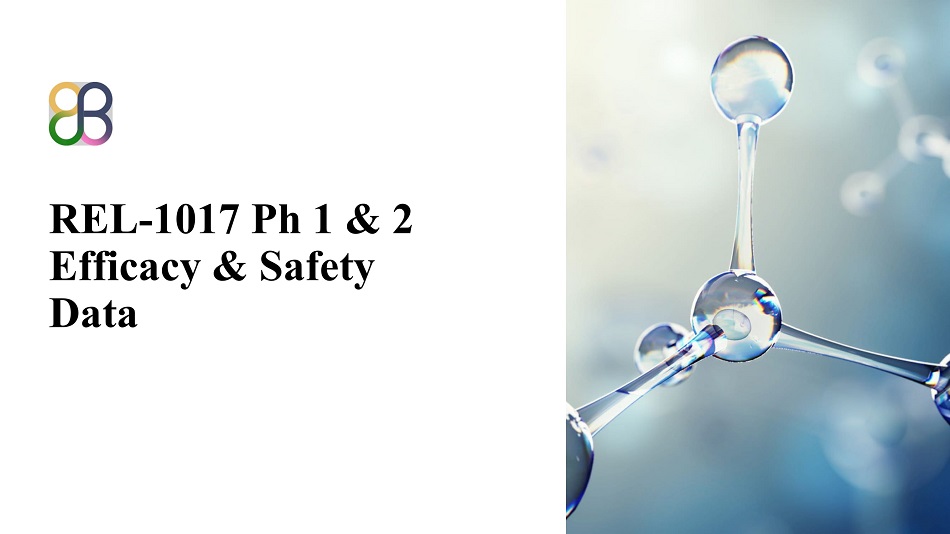
REL - 1017 Ph 1 & 2 Efficacy & Safety Data
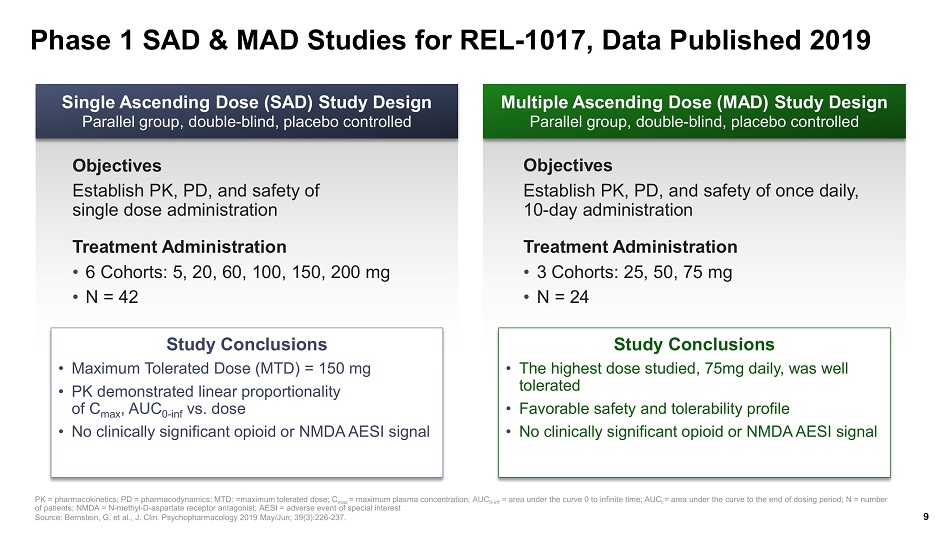
Phase 1 SAD & MAD Studies for REL - 1017, Data Published 2019 PK = pharmacokinetics; PD = pharmacodynamics; MTD: =maximum tolerated dose; C max = maximum plasma concentration ; AUC 0 - inf = area under the curve 0 to infinite time; AUC t = area under the curve to the end of dosing period; N = number of patients; NMDA = N - methyl - D - aspartate receptor antagonist; AESI = adverse event of special interest Source: Bernstein, G. et al., J. Clin. Psychopharmacology 2019 May/Jun; 39(3):226 - 237. Multiple Ascending Dose (MAD) Study Design Parallel group, double - blind, placebo controlled Single Ascending Dose (SAD) Study Design Parallel group, double - blind, placebo controlled Objectives Establish PK, PD, and safety of single dose administration Treatment Administration • 6 Cohorts: 5, 20, 60, 100, 150, 200 mg • N = 42 Objectives Establish PK, PD, and safety of once daily, 10 - day administration Treatment Administration • 3 Cohorts: 25, 50, 75 mg • N = 24 Study Conclusions • Maximum Tolerated Dose (MTD) = 150 mg • PK demonstrated linear proportionality of C max , AUC 0 - inf vs. dose • No clinically significant opioid or NMDA AESI signal Study Conclusions • The highest dose studied, 75mg daily, was well tolerated • Favorable safety and tolerability profile • No clinically significant opioid or NMDA AESI signal 9
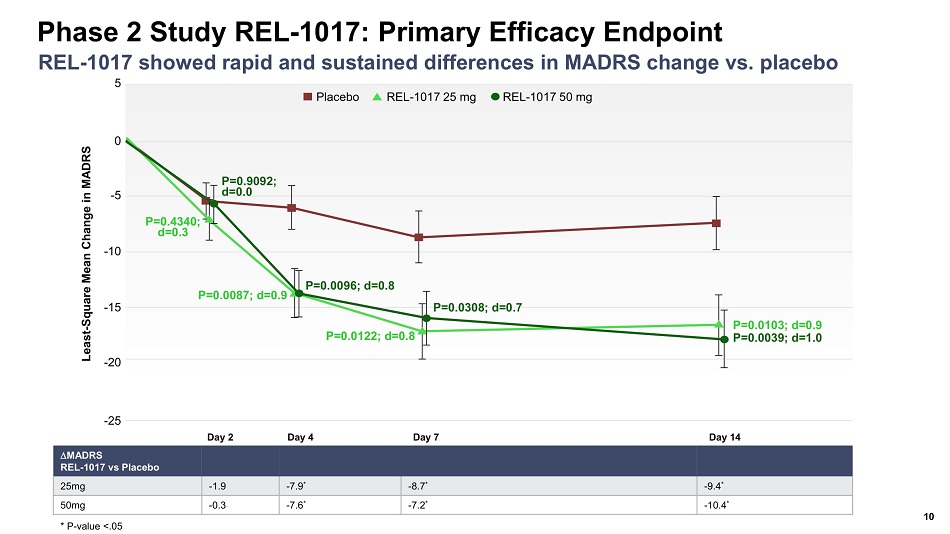
Phase 2 Study REL - 1017: Primary Efficacy Endpoint 10 REL - 1017 showed rapid and sustained differences in MADRS change vs. placebo Day 2 Day 4 Day 7 Day 14 5 0 - 5 - 25 Least - Square Mean Change in MADRS - 15 - 20 P=0.0103; d=0.9 P=0.0039; d=1.0 P=0.0308; d=0.7 P=0.0122; d=0.8 P=0.0096; d=0.8 P=0.0087; d=0.9 P=0.9092; d=0.0 P=0.4340; d=0.3 - 10 Placebo REL - 1017 25 mg REL - 1017 50 mg MADRS REL - 1017 vs Placebo 25mg - 1.9 - 7.9 * - 8.7 * - 9.4 * 50mg - 0.3 - 7.6 * - 7.2 * - 10.4 * * P - value <.05
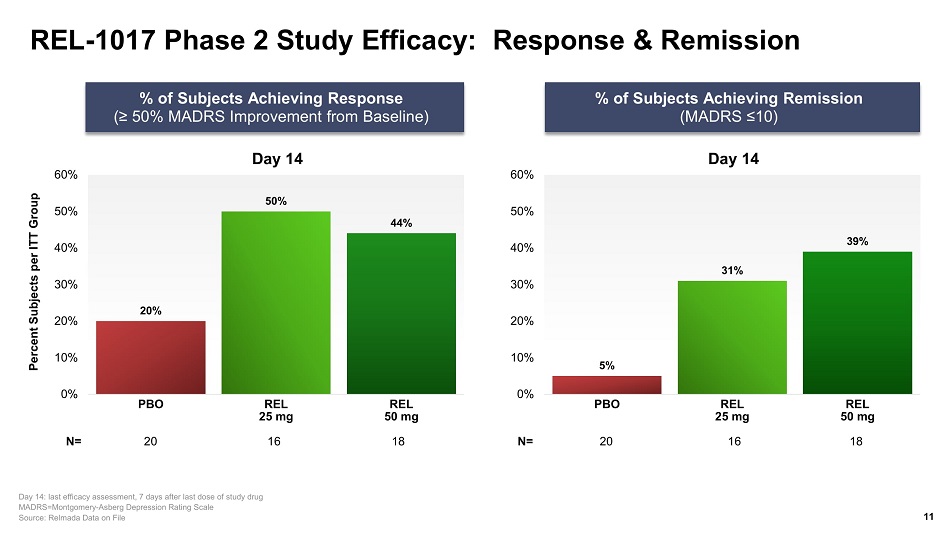
REL - 1017 Phase 2 Study Efficacy: Response & Remission % of Subjects Achieving Remission (MADRS ≤10) Percent Subjects per ITT Group % of Subjects Achieving Response (≥ 50% MADRS Improvement from Baseline) 11 Day 14: last efficacy assessment, 7 days after last dose of study drug MADRS=Montgomery - Asberg Depression Rating Scale Source: Relmada Data on File Day 14 20% 50% 44% 0% 10% 20% 30% 40% 50% 60% Day 14 5% 31% 39% 0% PBO REL REL PBO REL REL N= 20 25 mg 16 50 mg 18 N= 20 25 mg 16 50 mg 18 10% 20% 30% 40% 50% 60%
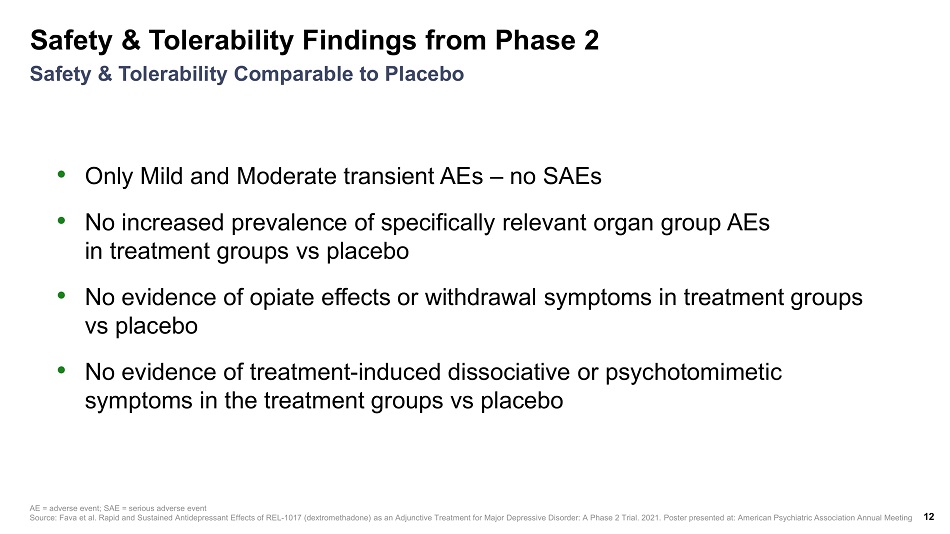
Safety & Tolerability Findings from Phase 2 Safety & Tolerability Comparable to Placebo • Only Mild and Moderate transient AEs – no SAEs • No increased prevalence of specifically relevant organ group AEs in treatment groups vs placebo • No evidence of opiate effects or withdrawal symptoms in treatment groups vs placebo • No evidence of treatment - induced dissociative or psychotomimetic symptoms in the treatment groups vs placebo 12 AE = adverse event; SAE = serious adverse event Source: Fava et al. Rapid and Sustained Antidepressant Effects of REL - 1017 (dextromethadone) as an Adjunctive Treatment for Major Depressive Disorder: A Phase 2 Trial. 2021. Poster presented at: American Psychiatric Association Annual Meeting
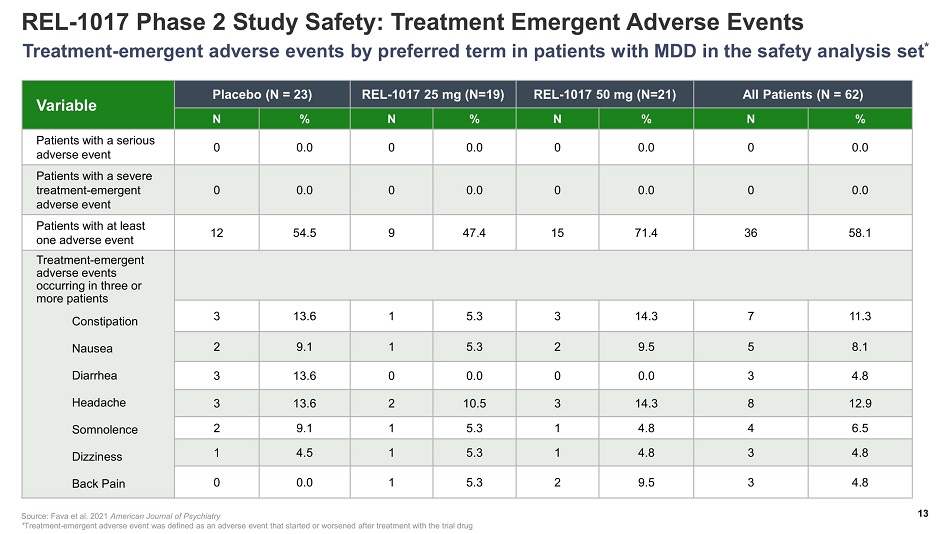
REL - 1017 Phase 2 Study Safety: Treatment Emergent Adverse Events Treatment - emergent adverse events by preferred term in patients with MDD in the safety analysis set * Variable Placebo (N = 23) REL - 1017 25 mg (N=19) REL - 1017 50 mg (N=21) All Patients (N = 62) N % N % N % N % Patients with a serious adverse event 0 0.0 0 0.0 0 0.0 0 0.0 Patients with a severe treatment - emergent adverse event 0 0.0 0 0.0 0 0.0 0 0.0 Patients with at least one adverse event 12 54.5 9 47.4 15 71.4 36 58.1 Treatment - emergent adverse events occurring in three or more patients Constipation Nausea Diarrhea Headache Somnolence Dizziness Back Pain 3 13.6 1 5.3 3 14.3 7 11.3 2 9.1 1 5.3 2 9.5 5 8.1 3 13.6 0 0.0 0 0.0 3 4.8 3 13.6 2 10.5 3 14.3 8 12.9 2 9.1 1 5.3 1 4.8 4 6.5 1 4.5 1 5.3 1 4.8 3 4.8 0 0.0 1 5.3 2 9.5 3 4.8 Source: Fava et al. 2021 American Journal of Psychiatry * Treatment - emergent adverse event was defined as an adverse event that started or worsened after treatment with the trial drug 13
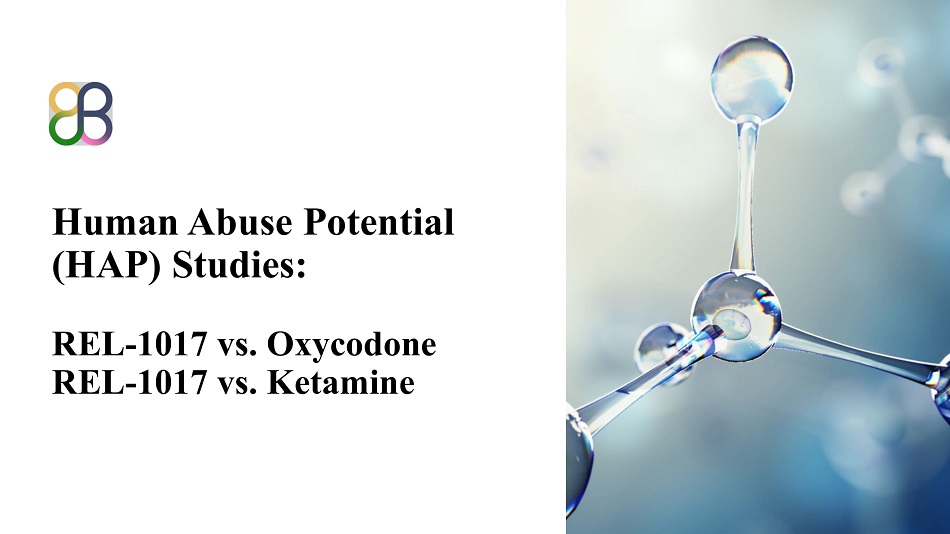
Human Abuse Potential (HAP) Studies: REL - 1017 vs. Oxycodone REL - 1017 vs. Ketamine
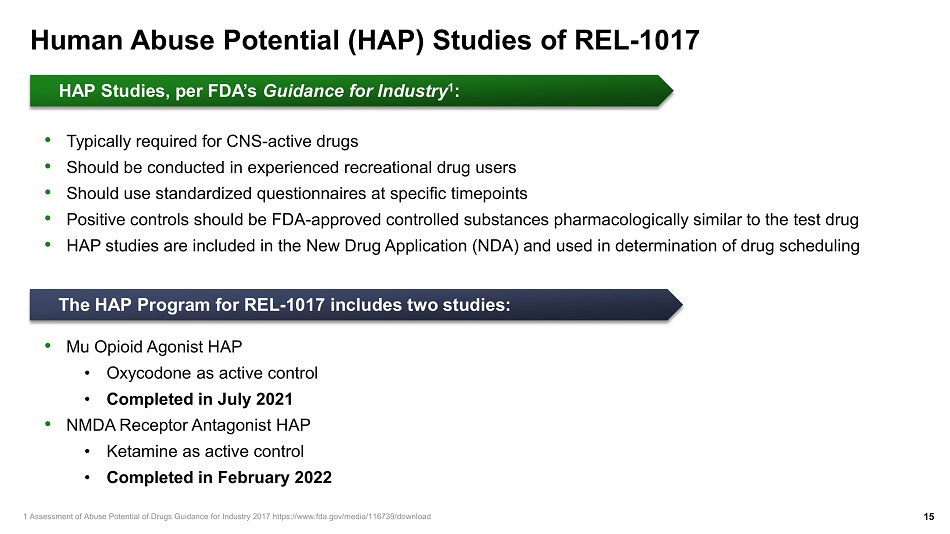
Human Abuse Potential (HAP) Studies of REL - 1017 15 HAP Studies, per FDA’s Guidance for Industry 1 : The HAP Program for REL - 1017 includes two studies: • Mu Opioid Agonist HAP • Oxycodone as active control • Completed in July 2021 • NMDA Receptor Antagonist HAP • Ketamine as active control • Completed in February 2022 1 Assessment of Abuse Potential of Drugs Guidance for Industry 2017 https:// www.fda.gov/media/116739/download • Typically required for CNS - active drugs • Should be conducted in experienced recreational drug users • Should use standardized questionnaires at specific timepoints • Positive controls should be FDA - approved controlled substances pharmacologically similar to the test drug • HAP studies are included in the New Drug Application (NDA) and used in determination of drug scheduling
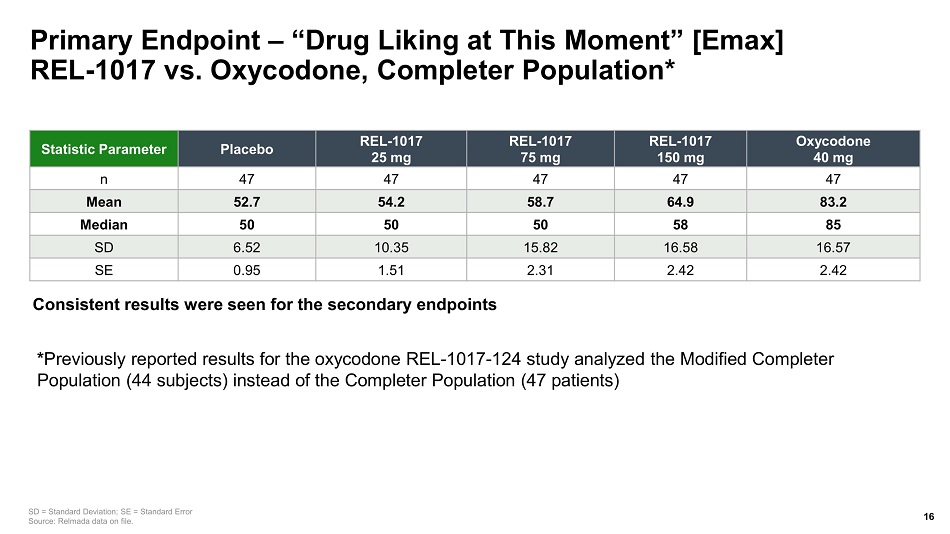
Primary Endpoint – “Drug Liking at This Moment” [Emax] REL - 1017 vs. Oxycodone, Completer Population* Statistic Parameter Placebo REL - 1017 25 mg REL - 1017 75 mg REL - 1017 150 mg Oxycodone 40 mg n 47 47 47 47 47 Mean 52.7 54.2 58.7 64.9 83.2 Median 50 50 50 58 85 SD 6.52 10.35 15.82 16.58 16.57 SE 0.95 1.51 2.31 2.42 2.42 SD = Standard Deviation; SE = Standard Error Source: Relmada data on file. Consistent results were seen for the secondary endpoints * Previously reported results for the oxycodone REL - 1017 - 124 study analyzed the Modified Completer Population (44 subjects) instead of the Completer Population (47 patients) 16
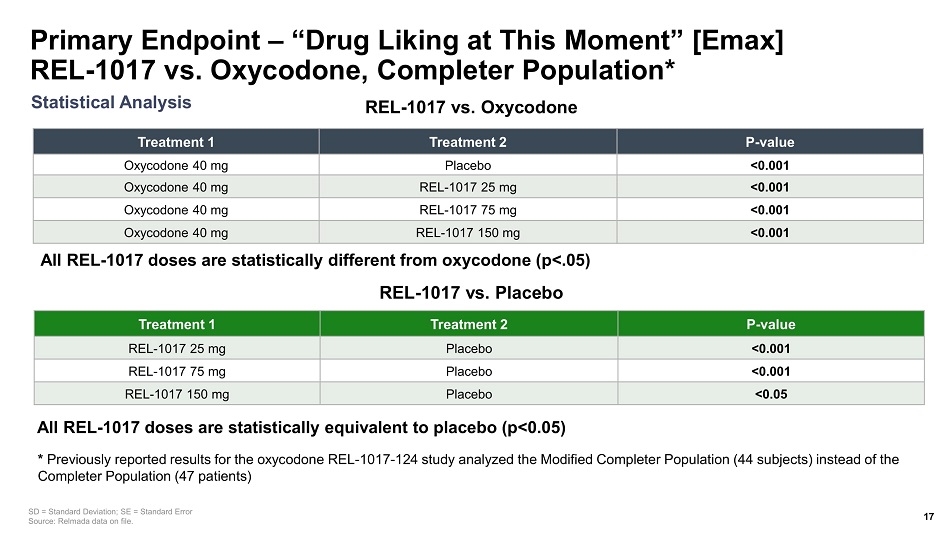
Primary Endpoint – “Drug Liking at This Moment” [Emax] REL - 1017 vs. Oxycodone, Completer Population* Treatment 1 Treatment 2 P - value Oxycodone 40 mg Placebo <0.001 Oxycodone 40 mg REL - 1017 25 mg <0.001 Oxycodone 40 mg REL - 1017 75 mg <0.001 Oxycodone 40 mg REL - 1017 150 mg <0.001 Statistical Analysis SD = Standard Deviation; SE = Standard Error Source: Relmada data on file. All REL - 1017 doses are statistically equivalent to placebo (p<0.05) * Previously reported results for the oxycodone REL - 1017 - 124 study analyzed the Modified Completer Population (44 subjects) instead of the Completer Population (47 patients) 17 Treatment 1 Treatment 2 P - value REL - 1017 25 mg Placebo <0.001 REL - 1017 75 mg Placebo <0.001 REL - 1017 150 mg Placebo <0.05 REL - 1017 vs. Oxycodone All REL - 1017 doses are statistically different from oxycodone (p<.05) REL - 1017 vs. Placebo
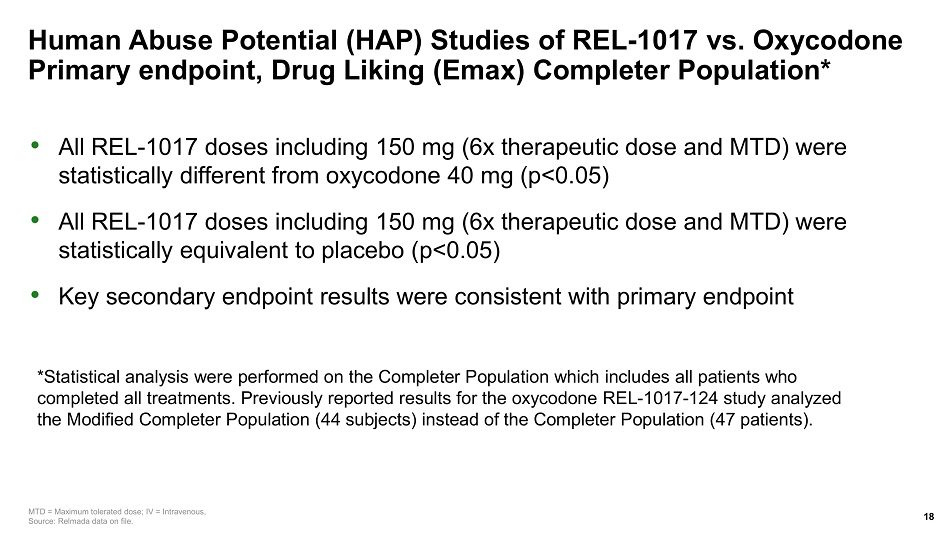
Human Abuse Potential (HAP) Studies of REL - 1017 vs. Oxycodone Primary endpoint, Drug Liking (Emax) Completer Population* • All REL - 1017 doses including 150 mg (6x therapeutic dose and MTD) were statistically different from oxycodone 40 mg (p<0.05) • All REL - 1017 doses including 150 mg (6x therapeutic dose and MTD) were statistically equivalent to placebo (p<0.05) • Key secondary endpoint results were consistent with primary endpoint 18 MTD = Maximum tolerated dose; IV = Intravenous, Source: Relmada data on file. *Statistical analysis were performed on the Completer Population which includes all patients who completed all treatments. Previously reported results for the oxycodone REL - 1017 - 124 study analyzed the Modified Completer Population (44 subjects) instead of the Completer Population (47 patients).
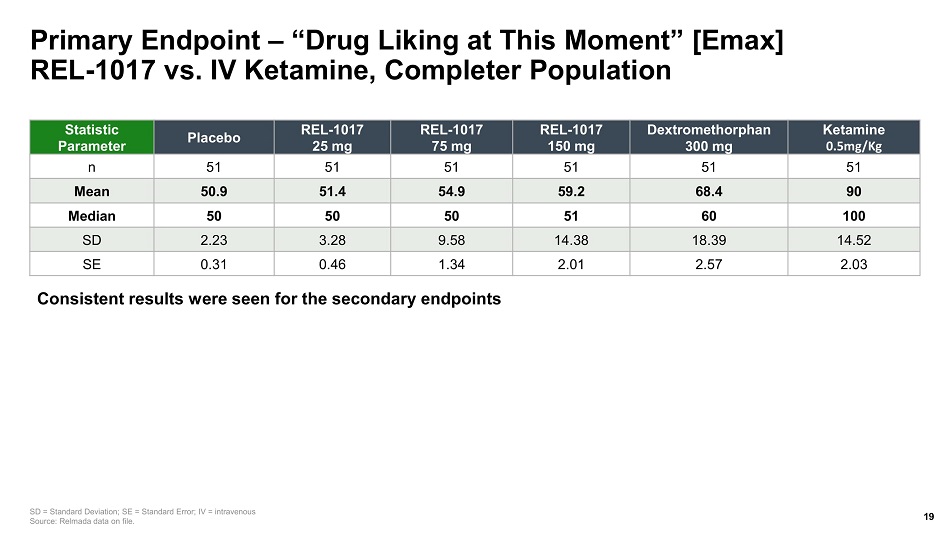
Primary Endpoint – “Drug Liking at This Moment” [Emax] REL - 1017 vs. IV Ketamine, Completer Population Statistic Parameter Placebo REL - 1017 25 mg REL - 1017 75 mg REL - 1017 150 mg Dextromethorphan 300 mg Ketamine 0.5mg/Kg n 51 51 51 51 51 51 Mean 50.9 51.4 54.9 59.2 68.4 90 Median 50 50 50 51 60 100 SD 2.23 3.28 9.58 14.38 18.39 14.52 SE 0.31 0.46 1.34 2.01 2.57 2.03 SD = Standard Deviation; SE = Standard Error; IV = intravenous Source: Relmada data on file. Consistent results were seen for the secondary endpoints 19
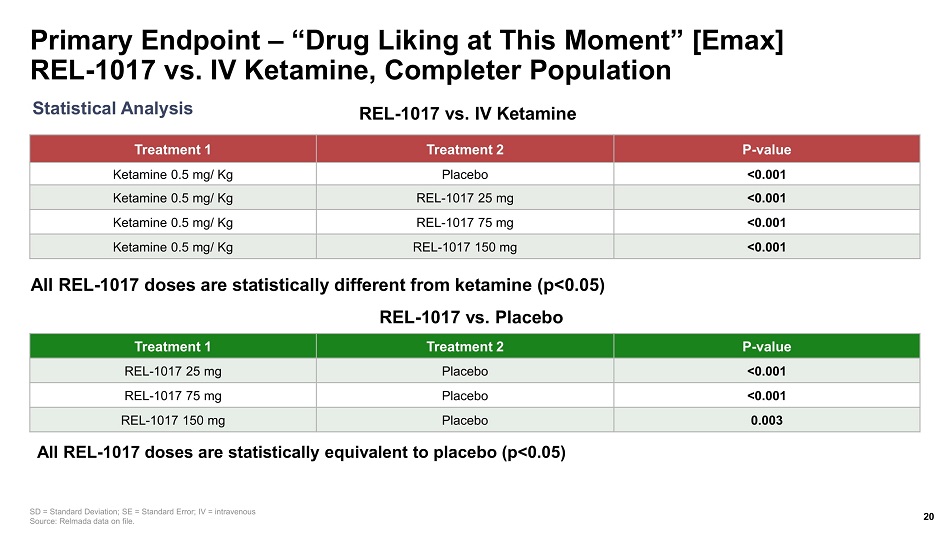
Primary Endpoint – “Drug Liking at This Moment” [Emax] REL - 1017 vs. IV Ketamine, Completer Population Treatment 1 Treatment 2 P - value Ketamine 0.5 mg/ Kg Placebo <0.001 Ketamine 0.5 mg/ Kg REL - 1017 25 mg <0.001 Ketamine 0.5 mg/ Kg REL - 1017 75 mg <0.001 Ketamine 0.5 mg/ Kg REL - 1017 150 mg <0.001 Statistical Analysis SD = Standard Deviation; SE = Standard Error; IV = intravenous Source: Relmada data on file. All REL - 1017 doses are statistically equivalent to placebo (p<0.05) 20 Treatment 1 Treatment 2 P - value REL - 1017 25 mg Placebo <0.001 REL - 1017 75 mg Placebo <0.001 REL - 1017 150 mg Placebo 0.003 REL - 1017 vs. IV Ketamine All REL - 1017 doses are statistically different from ketamine (p<0.05) REL - 1017 vs. Placebo
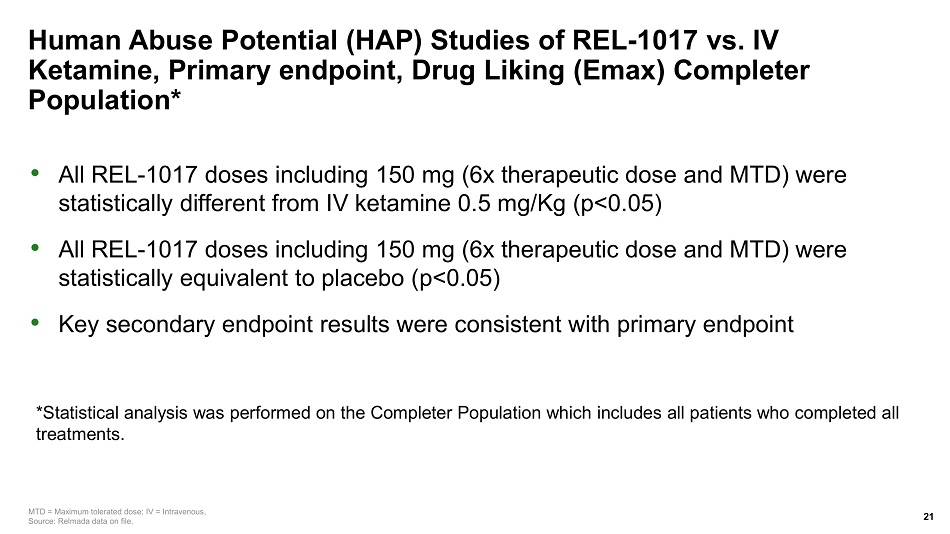
Human Abuse Potential (HAP) Studies of REL - 1017 vs. IV Ketamine, Primary endpoint, Drug Liking (Emax) Completer Population* • All REL - 1017 doses including 150 mg (6x therapeutic dose and MTD) were statistically different from IV ketamine 0.5 mg/Kg (p<0.05) • All REL - 1017 doses including 150 mg (6x therapeutic dose and MTD) were statistically equivalent to placebo (p<0.05) • Key secondary endpoint results were consistent with primary endpoint 21 MTD = Maximum tolerated dose; IV = Intravenous, Source: Relmada data on file. *Statistical analysis was performed on the Completer Population which includes all patients who completed all treatments.
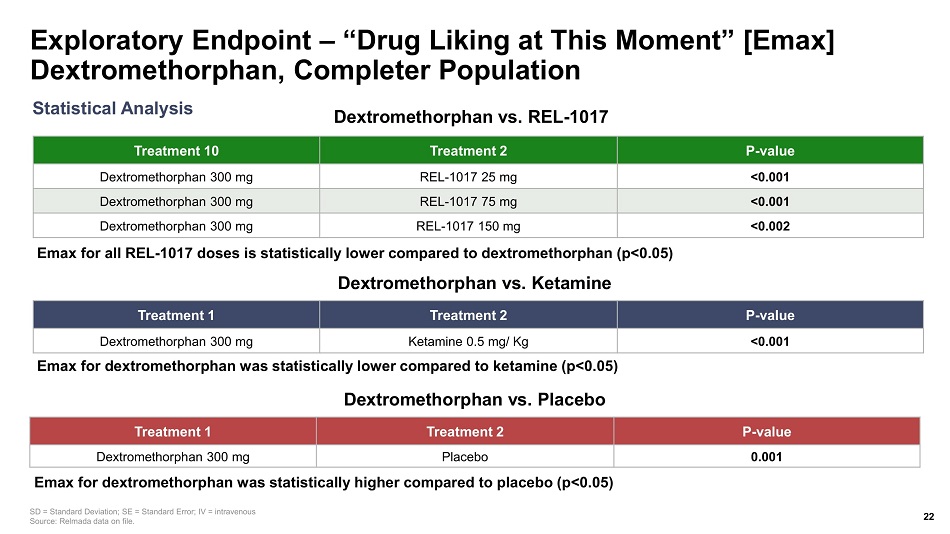
Exploratory Endpoint – “Drug Liking at This Moment” [Emax] Dextromethorphan, Completer Population Treatment 1 Treatment 2 P - value Dextromethorphan 300 mg Placebo 0.001 Statistical Analysis SD = Standard Deviation; SE = Standard Error; IV = intravenous Source: Relmada data on file. 22 Dextromethorphan vs. REL - 1017 Treatment 1 Treatment 2 P - value Dextromethorphan 300 mg Ketamine 0.5 mg/ Kg <0.001 Treatment 10 Treatment 2 P - value Dextromethorphan 300 mg REL - 1017 25 mg <0.001 Dextromethorphan 300 mg REL - 1017 75 mg <0.001 Dextromethorphan 300 mg REL - 1017 150 mg <0.002 Emax for all REL - 1017 doses is statistically lower compared to dextromethorphan (p<0.05) Dextromethorphan vs. Ketamine Emax for dextromethorphan was statistically lower compared to ketamine (p<0.05) Dextromethorphan vs. Placebo Emax for dextromethorphan was statistically higher compared to placebo (p<0.05)
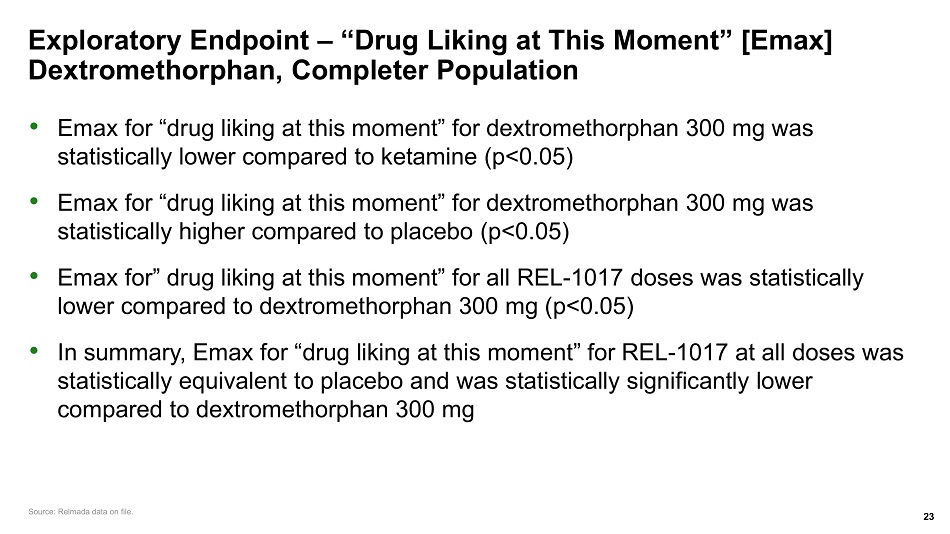
Exploratory Endpoint – “Drug Liking at This Moment” [Emax] Dextromethorphan, Completer Population • Emax for “drug liking at this moment” for dextromethorphan 300 mg was statistically lower compared to ketamine (p<0.05) • Emax for “drug liking at this moment” for dextromethorphan 300 mg was statistically higher compared to placebo (p<0.05) • Emax for” drug liking at this moment” for all REL - 1017 doses was statistically lower compared to dextromethorphan 300 mg (p<0.05) • In summary, Emax for “drug liking at this moment” for REL - 1017 at all doses was statistically equivalent to placebo and was statistically significantly lower compared to dextromethorphan 300 mg 23 Source: Relmada data on file.
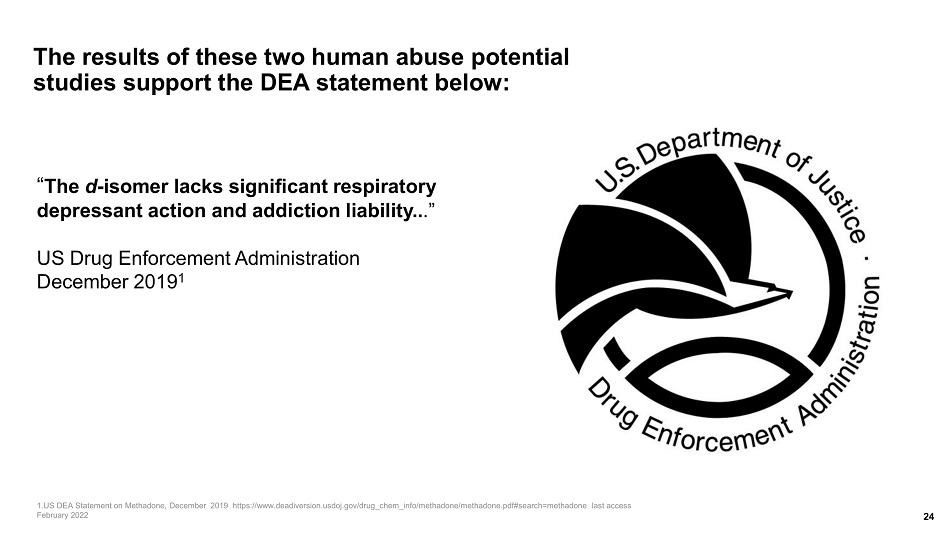
The results of these two human abuse potential studies support the DEA statement below: 24 “ The d - isomer lacks significant respiratory depressant action and addiction liability.. .” US Drug Enforcement Administration December 2019 1 1.US DEA Statement on Methadone, December 2019 https:// www.deadiversion.usdoj.gov/drug_chem_info/methadone/methadone.pdf#search=methadone last access February 2022
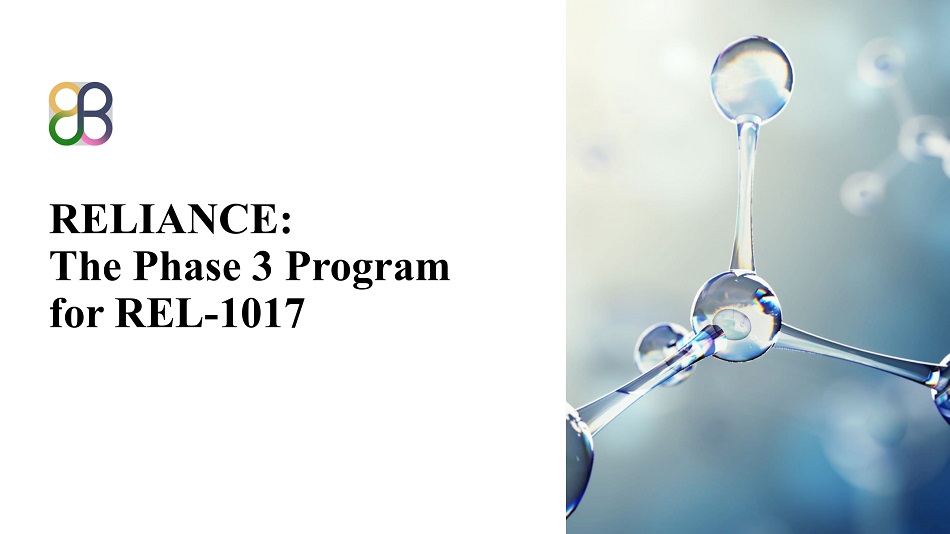
RELIANCE: The Phase 3 Program for REL - 1017
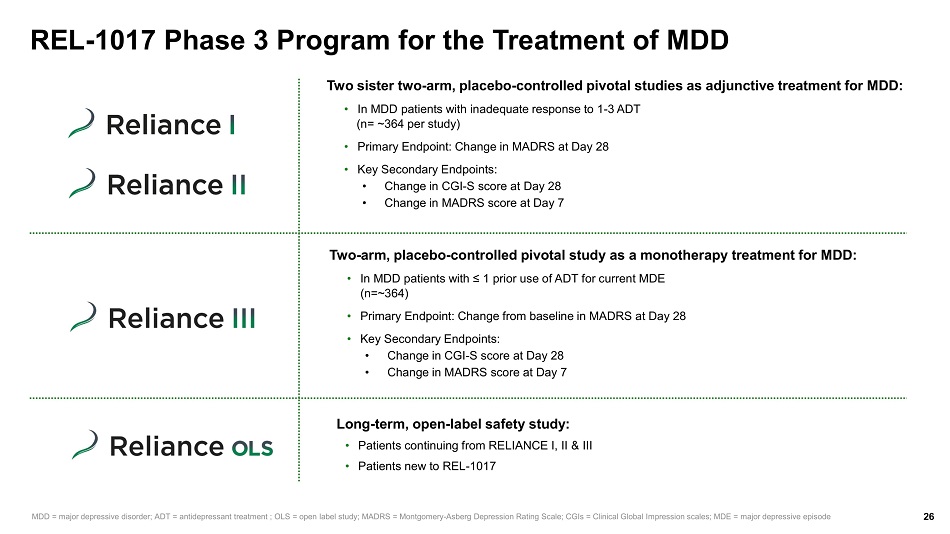
REL - 1017 Phase 3 Program for the Treatment of MDD 26 Two sister two - arm, placebo - controlled pivotal studies as adjunctive treatment for MDD: • In MDD patients with inadequate response to 1 - 3 ADT (n= ~364 per study) • Primary Endpoint: Change in MADRS at Day 28 • Key Secondary Endpoints: • Change in CGI - S score at Day 28 • Change in MADRS score at Day 7 Two - arm, placebo - controlled pivotal study as a monotherapy treatment for MDD: • In MDD patients with ≤ 1 prior use of ADT for current MDE (n=~364) • Primary Endpoint: Change from baseline in MADRS at Day 28 • Key Secondary Endpoints: • Change in CGI - S score at Day 28 • Change in MADRS score at Day 7 Long - term, open - label safety study: • Patients continuing from RELIANCE I, II & III • Patients new to REL - 1017 MDD = major depressive disorder; ADT = antidepressant treatment ; OLS = open label study; MADRS = Montgomery - Asberg Depression Rating Scale; CGIs = Clinical Global Impression scales; MDE = major depressive episode
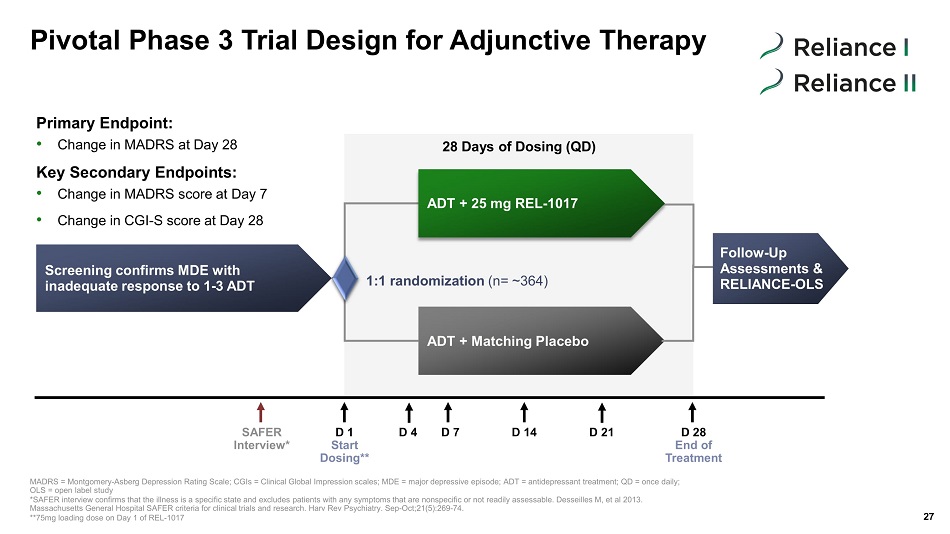
Screening confirms MDE with inadequate response to 1 - 3 ADT ADT + 25 mg REL - 1017 ADT + Matching Placebo Pivotal Phase 3 Trial Design for Adjunctive Therapy 27 1:1 randomization (n= ~364) 28 Days of Dosing (QD) Follow - Up Assessments & RELIANCE - OLS SAFER Interview* D 1 Start Dosing** D 4 D 7 D 14 D 28 End of Treatment D 21 MADRS = Montgomery - Asberg Depression Rating Scale; CGIs = Clinical Global Impression scales; MDE = major depressive episode; ADT = antidepressant treatment; QD = once daily; OLS = open label study *SAFER interview confirms that the illness is a specific state and excludes patients with any symptoms that are nonspecific or not readily assessable. Desseilles M, et al 2013. Massachusetts General Hospital SAFER criteria for clinical trials and research. Harv Rev Psychiatry. Sep - Oct;21(5):269 - 74. **75mg loading dose on Day 1 of REL - 1017 Primary Endpoint: • Change in MADRS at Day 28 Key Secondary Endpoints: • Change in MADRS score at Day 7 • Change in CGI - S score at Day 28
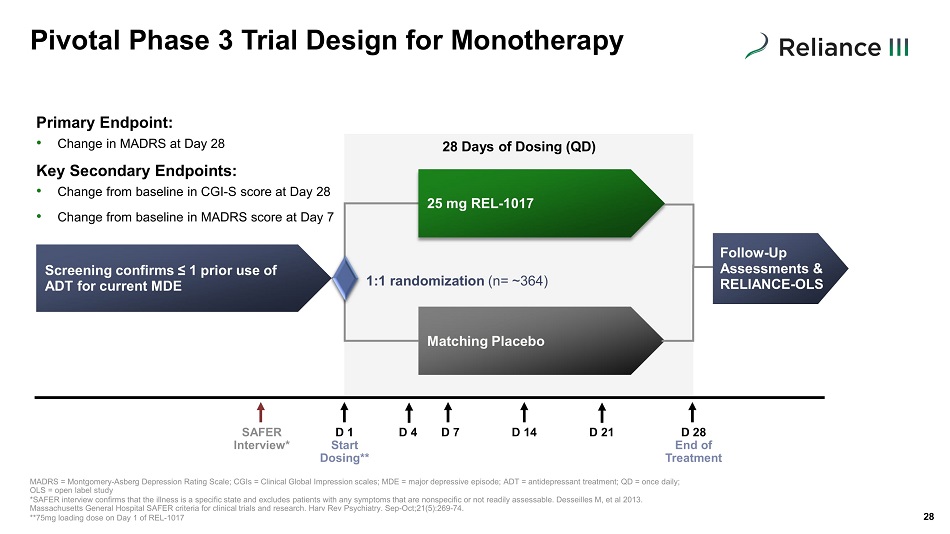
Screening confirms ≤ 1 prior use of ADT for current MDE 25 mg REL - 1017 Matching Placebo Pivotal Phase 3 Trial Design for Monotherapy 28 Primary Endpoint: • Change in MADRS at Day 28 Key Secondary Endpoints: • Change from baseline in CGI - S score at Day 28 • Change from baseline in MADRS score at Day 7 1:1 randomization (n= ~364) 28 Days of Dosing (QD) Follow - Up Assessments & RELIANCE - OLS SAFER Interview* D 1 Start Dosing** D 4 D 7 D 14 D 28 End of Treatment D 21 MADRS = Montgomery - Asberg Depression Rating Scale; CGIs = Clinical Global Impression scales; MDE = major depressive episode; ADT = antidepressant treatment; QD = once daily; OLS = open label study *SAFER interview confirms that the illness is a specific state and excludes patients with any symptoms that are nonspecific or not readily assessable. Desseilles M, et al 2013. Massachusetts General Hospital SAFER criteria for clinical trials and research. Harv Rev Psychiatry. Sep - Oct;21(5):269 - 74. **75mg loading dose on Day 1 of REL - 1017
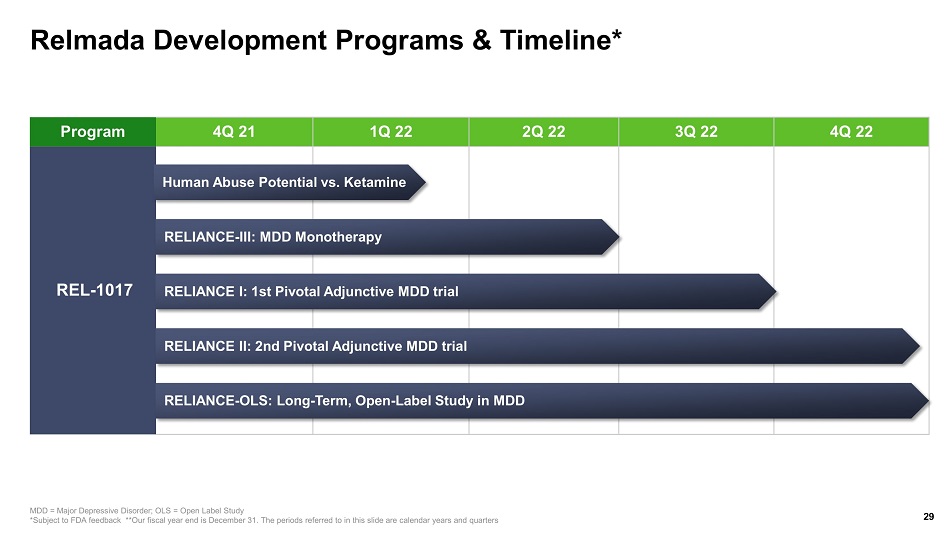
Relmada Development Programs & Timeline* 29 MDD = Major Depressive Disorder; OLS = Open Label Study *Subject to FDA feedback **Our fiscal year end is December 31. The periods referred to in this slide are calendar years and quarters Program 4Q 21 1Q 22 2Q 22 3Q 22 4Q 22 REL - 1017 RELIANCE I: 1st Pivotal Adjunctive MDD trial RELIANCE II: 2nd Pivotal Adjunctive MDD trial RELIANCE - OLS: Long - Term, Open - Label Study in MDD Human Abuse Potential vs. Ketamine RELIANCE - III: MDD Monotherapy
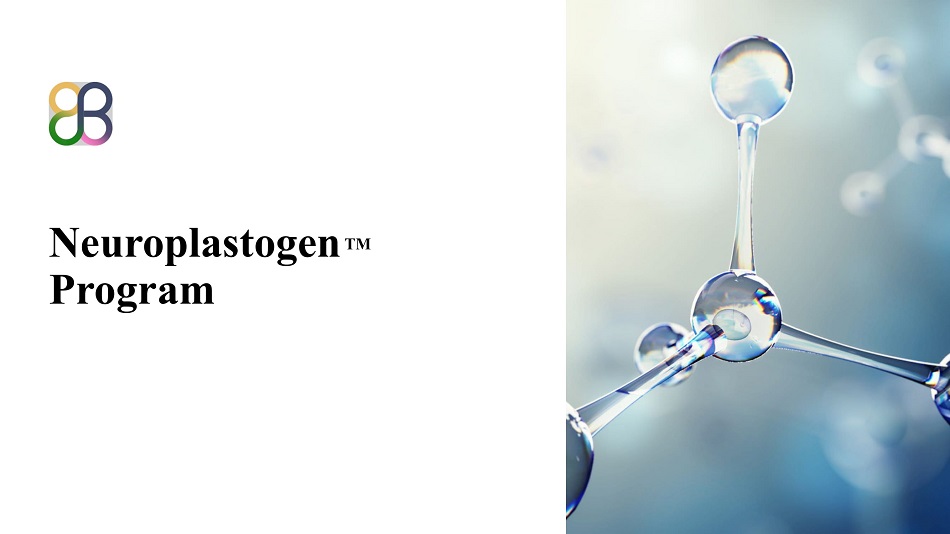
Neuroplastogen TM Program
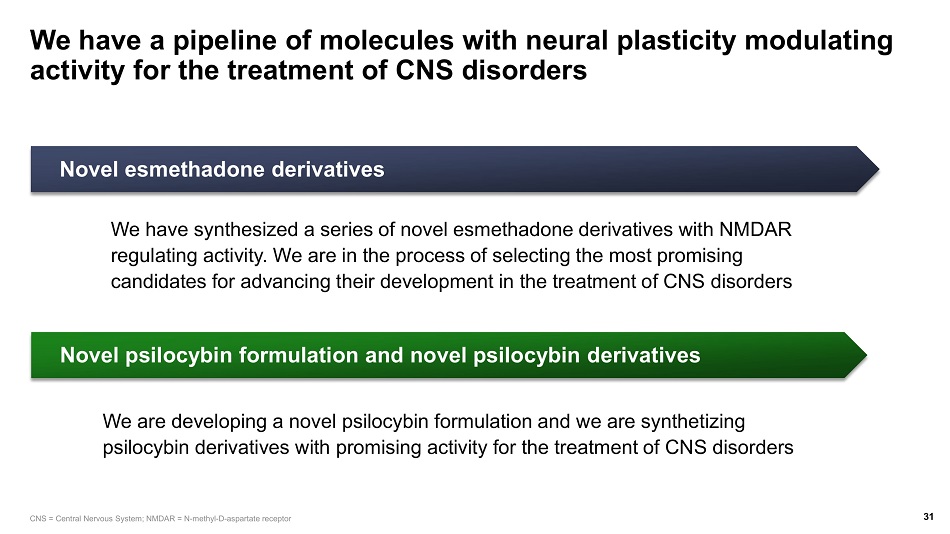
We have a pipeline of molecules with neural plasticity modulating activity for the treatment of CNS disorders 31 We are developing a novel psilocybin formulation and we are synthetizing psilocybin derivatives with promising activity for the treatment of CNS disorders We have synthesized a series of novel esmethadone derivatives with NMDAR regulating activity. We are in the process of selecting the most promising candidates for advancing their development in the treatment of CNS disorders Novel esmethadone derivatives Novel psilocybin formulation and novel psilocybin derivatives CNS = Central Nervous System; NMDAR = N - methyl - D - aspartate receptor

Corporate Information
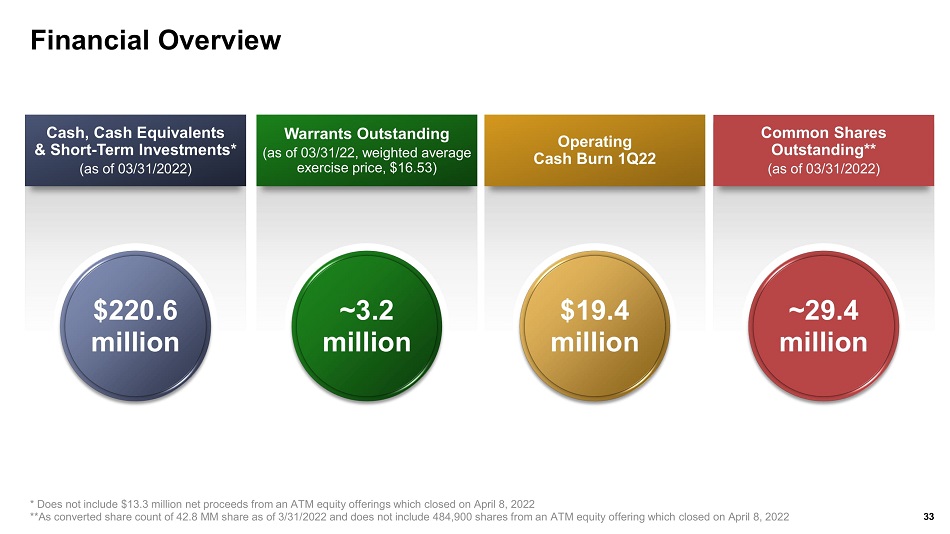
Financial Overview Cash, Cash Equivalents & Short - Term Investments* (as of 03/31/2022) $220.6 million Warrants Outstanding (as of 03/31/22, weighted average exercise price, $16.53) ~3.2 million Operating Cash Burn 1Q22 $19.4 million Common Shares Outstanding** (as of 03/31/2022) ~29.4 million 33 * Does not include $13.3 million net proceeds from an ATM equity offerings which closed on April 8, 2022 **As converted share count of 42.8 MM share as of 3/31/2022 and does not include 484,900 shares from an ATM equity offering which closed on April 8, 2022
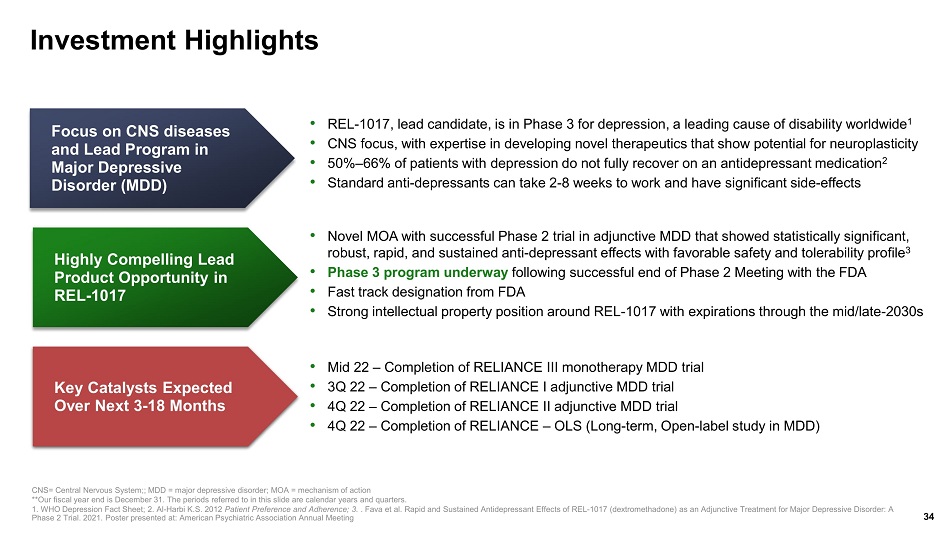
Investment Highlights Highly Compelling Lead Product Opportunity in REL - 1017 Key Catalysts Expected Over Next 3 - 18 Months Focus on CNS diseases and Lead Program in Major Depressive Disorder (MDD) CNS= Central Nervous System;; MDD = major depressive disorder; MOA = mechanism of action **Our fiscal year end is December 31. The periods referred to in this slide are calendar years and quarters. 1. WHO Depression Fact Sheet; 2. Al - Harbi K.S. 2012 Patient Preference and Adherence; 3. . Fava et al. Rapid and Sustained Antidepressant Effects of REL - 1017 (dextromethadone) as an Adjunctive Treatment for Major Depressive Disorder: A Phase 2 Trial. 2021. Poster presented at: American Psychiatric Association Annual Meeting 34 • Novel MOA with successful Phase 2 trial in adjunctive MDD that showed statistically significant, robust, rapid, and sustained anti - depressant effects with favorable safety and tolerability profile 3 • Phase 3 program underway following successful end of Phase 2 Meeting with the FDA • Fast track designation from FDA • Strong intellectual property position around REL - 1017 with expirations through the mid/late - 2030s • REL - 1017, lead candidate, is in Phase 3 for depression, a leading cause of disability worldwide 1 • CNS focus, with expertise in developing novel therapeutics that show potential for neuroplasticity • 50% – 66% of patients with depression do not fully recover on an antidepressant medication 2 • Standard anti - depressants can take 2 - 8 weeks to work and have significant side - effects • Mid 22 – Completion of RELIANCE III monotherapy MDD trial • 3Q 22 – Completion of RELIANCE I adjunctive MDD trial • 4Q 22 – Completion of RELIANCE II adjunctive MDD trial • 4Q 22 – Completion of RELIANCE – OLS (Long - term, Open - label study in MDD)